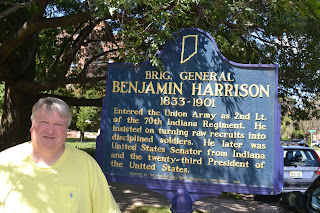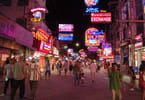“When the frost is on the punkin and the fodder’s in the shock” is the opening line from one of James Whitcomb Riley’s famous poems. He glorified his rural Indiana childhood in such poems as “The Old Swimmin’ Hole” and “Little Orphan Annie.” These cultural gems, and so much more will be highlighted beginning December 11, as the state of Indiana prepares for its 200th birthday celebration in 2016. Indiana is a conservative, rather modest and humble state that espouses old-fashioned values. It is the home of The Saturday Evening Post, the nostalgic magazine that made Norman Rockwell’s paintings world famous. It is the home of James Whitcomb Riley’s friend Johnny Gruelle, children’s book author and illustrator who created Raggedy Ann and Raggedy Andy. It is also the home of the Ball brothers, famous for their light blue glass home-canning jars, still prized today for their wholesome, charming practicalities. “Take Me Out To The Ball Game” was written by an Indiana native, Albert Von Tilzer.
I grew up in Indiana, way out in the hinterland where Mennonites rode their horse-driven buggies. The nearest town was miles away. I was like Eva Gabor in Green Acres, allergic to smelling hay and confused by all the rituals that go along with an ultra-conservative culture. The culture has not changed much since I left in 1985; earlier this year Memories Pizza in Walkerton, Indiana, said they would not serve pizza at a gay wedding. It made the eatery famous and they received almost a million dollars in donations from fellow conservatives who wished to support them. When I was a child, openly gay men in our county were denied more than just pizza. Kenneth Eugene Moss and Gerald Shafer were abducted, tortured, mutilated and left to rot in amber fields of grain as a warning to others who might embark on the “gay lifestyle.”
Indiana is the home of Jared Fogle, former spokesman for Subway restaurants. He became famous for telling people what to put in their mouth. Ironic, eh? I guess it was a good gig while it lasted. Indiana has the ninth highest obesity rate in the nation, Time reported in 2013. If I had to guess why people from Indiana are so fat, I would guess it is cultural.
People from Indiana tend to have strong beliefs when it comes to religion. After George Went Hensley made his way through Indiana introducing snake-handling practices to the fundamentalists, this was the most exciting thing to do in many communities. I was raised in a fundamentalist church which forbade dancing, drinking, watching porn or doing anything “of the world.” There were other churches nearby which forbade females from cutting their hair or wearing slacks. Of course, the Mennonites were forbidden from using electricity or owning a car or joining a post-Victorian world. What did that leave? Eating and guilt. That’s a recipe for obesity if I ever saw one.
Of course, there are benefits to this conservative, agricultural culture. We never locked our doors when we left home. We kept the keys in our cars. It wasn’t necessary because people didn’t steal, unlike our home in Milan Italy, where people will steal anything not bolted to the ground. If you are looking for employees to perform back-breaking work all day long for poverty wages, you can find them in Indiana. Because in Indiana, many religious groups consider it a sin to be lazy. I grew up believing it was normal to have a day job, a night job, and a third job on weekends. God forbid you ever let your house get dirty, because cleanliness is next to godliness.
My inner Eva Gabor couldn’t wait to adore a penthouse view, so I fled Green Acres as soon as I graduated college. Of course, parts of the culture stay with a person forever, and at times I did miss my “Saturday Evening Post” Norman Rockwell heritage, especially after a home burglary or corruption scandal in my adopted town, the filthy ghetto of Detroit. The first week I moved to Detroit, someone siphoned the gasoline out of my tank. Then within a year, my friend’s car was stolen while visiting me. I didn’t realize when I first moved to the ghetto there were suburbs that offered an alternate compromise between lifestyle and safety.
I took a road trip back to Indiana to relive some of the better moments from my youth. There were tremendous changes in the last 30 years, especially in our primate city, Indianapolis. It is primate because it is centrally located, the capital, and disproportionately larger than other towns in the state. When I lived there, it was a giant dump. In the 1970s and 1980s, Indianapolis suffered from urban decay and white flight. After I fled, major revitalization of the city’s blighted areas, such as Fall Creek Place and Downtown Indianapolis began. More than $5 billion has been invested into the downtown Indianapolis area since 1990. It is completely unrecognizable today from its former self.
Like a Phoenix rising from the ashes, Indianapolis is now a radiant gem. Locals call their town Indy, homonym with indie (independent from past associations). Indy is, arguably, completely new and has reinvented itself for the better. We explored the area with Indy’s premier tour company, Circle City Tours, guided by visionary Carrie Savage-Zimmerman. She founded the company after writing the script for a film about the city; it seemed a waste to let all that research be put on a shelf. We had heard she was a walking encyclopedia after tourists posted reviews about her on social media, so she was our first choice as a tour guide. We were blown away by her knowledge and communication skills. Articulate and clever, she kept us fascinated with all the sites on her tour. Indianapolis is second only to Washington D.C. in its number of monuments and memorials; Carrie took us to her favorite – the Soldiers’ and Sailors’ Monument – a focal point and symbol of the city. The monument is a remarkable sculptural group of marble figures flanking an obelisk, and creates a dramatic civic space in a circular park. The quality of its sculpture, bronze work, and concept is unparalleled in the state. The Colonel Eli Lilly Civil War Museum is located on the interior of the magnificent monument.
Benjamin Harrison (1833–1901), twenty-third president of the United States, was a lawyer in Indianapolis; Carrie took us to see his mansion at 1230 N. Delaware Street. The Italianate red brick house has sixteen rooms and a front porch made famous during Harrison’s political campaigns. Over 75% of the 3,700 pieces of memorabilia inside the mansion actually belonged to Benjamin Harrison and his family. Harrison was the grandson of President William Henry Harrison, the 9th President of the United States. Benjamin was seven years old when his grandfather was elected president. This family had a lot of money. The Indianapolis mansion was constructed at a cost of half a billion dollars in today’s money. Although they had money, Harrison was both weird and had a cold personality – some considered him a heartless snakelike lawyer. Harrison was the first president to use electricity in the White House, installed by Edison General Electric Company. However, he and his wife would not touch the light switches for fear of being electrocuted and often went to bed with the lights left on.
Carrie took us to White River State Park, a 250-acre cultural district on the western edge of the downtown area. It did not exist when I lived in Indiana; at that time it was a giant blight-filled wasteland. The city stepped in and reconstructed everything in the area. Visionaries built a world-class zoo, botanical gardens, American Indian museum, art sculpture park, state museum and much more.
We visited the new zoo in the state park. It was astonishing. The Indianapolis Zoo is the only institution accredited by the Association of Zoos and Aquariums and the American Alliance of Museums as a zoo, an aquarium, and as a botanical garden. The zoo functions as an institution of conservation and education, not just a place to ogle exotic beasts. Researchers are actively engaged in studying animal behavior and development. We saw one scientist teaching an orangutan basic mathematics. The zoo hosts more than a million visitors each year and plays a role in cutting edge research, including accomplishing the world’s first successful artificial insemination of an African elephant.
Carrie took us to the North Meridian Street Historic District, where the wealthy and social elite built their mansions between World War I and World War II. One palatial estate became the home of famous Hoosier author Booth Tarkington from 1923 until his death in 1946. A two-time Pulitzer prizewinner, Tarkington earned wealth from his novels based on Indiana families and their surroundings, such as The Magnificent Ambersons. Tarkington described the houses in his neighborhood as having a “picture book house” appearance.
Our stop at Butler University was somewhat sad. For decades, the university presented summer theatre in the open air, known as Starlight Musicals, starring entertainment icons like Yul Brenner, Carol Burnett, Liberace, Jack Benny, and Liza Minnelli. I was young and platinum blond in those days when I attended a concert by Liberace. After the performance, I waited for him to get his autograph. When he saw me, he immediately hit on me, touching me to the point of being creepy. I wasn’t interested in a chain-smoking old man in a horrible wig; I only wanted his autograph. I learned that in 1993, Starlight Musicals shut down and the theatre was abandoned to decay. In 2005, the site was razed and replaced with student housing. Like most everything in Indianapolis, anything that was dilapidated got torn down and renewed. Indy is the East Berlin of the Midwest.
Our next stop was at the Indianapolis Motor Speedway, home to the Indy 500 races. The event, billed as The Greatest Spectacle in Racing, is considered part of the Triple Crown of Motorsport, which comprises three of the most prestigious motorsports events in the world: Indy 500, Grand Prix de Monaco, and 24 Hours of Le Mans. Visitors to the site can enjoy a narrated bus ride around the famed 2.5 mile track in one of the Speedway’s comfortable tour buses. More daring visitors can actually drive a race car around the track at speeds up to 180 miles per hour. Carrie said the Speedway is one of the most sought-after tourist spots on her tours.
Circle City Tours showed us the The Children’s Museum of Indianapolis, said to be the biggest and best children’s museum in the world. One of the interesting artifacts therein is a Raggedy Ann doll. The doll has been popular ever since Johnny Gruelle published Raggedy Ann Stories and the first Raggedy Ann dolls were made. The doll on display was made by a girl when she was in the 1st grade in 1929. One day she and her mother took her Raggedy Ann to the L.S. Ayres tea room in Indianapolis where Johnny Gruelle was signing books. Gruelle signed the doll for her, making it a collector’s item, indeed. This year – 2015 – Raggedy Ann celebrates her 100th birthday (and Andy, his 95th). Johnny Gruelle received US Patent D47789 for his Raggedy Ann doll on September 7, 1915.
South of Indianapolis is a magical city called Santa Claus. This famous town is home to the world’s only post office with the Santa Claus name Christmas-themed attractions for the entire family. It’s a place where Christmas is celebrated every day. There is at least a week’s worth of sightseeing in the area. It is home to a unique theme park, Holiday World, voted Cleanest Park in the World for more than a decade. As I mentioned earlier, people in Indiana are a bit fanatical about cleanliness. The amusement park is small by Disney standards, but unique to the point it deserves a visit. In the same neighborhood is Lincoln’s boyhood home. Abraham Lincoln moved to Indiana when he was 7 years old. He lived most of his boyhood life in Spencer County with his parents Thomas and Nancy. By virtue of his importance in American history, the area is loaded with sites dedicated to him. You will find Lincoln State Park, Lincoln Pioneer Village & Museum, Lincoln Boyhood National Memorial, and the Lincoln Amphitheatre, where plays are performed during the summer.
North of Indianapolis you will find Amish country. It is a rather spread-out territory, dotted by interesting craft shops and restaurants. As a child, we often went to Amish restaurants, long before farm to table eateries were in vogue. Since all dishes are made from organic produce, your palate will rejoice in the rich flavors of all-natural cuisine. Many farms sell home-made cheese, berry pies, fresh breads, and of course, jams preserved in those traditional Ball canning jars.
Sometimes, my inner Eva Gabor remembers fondly the simple, humble and conservative way of life in Indiana, especially this time of year when I see harvest decorations, pumpkin pies, and displays honoring our pilgrim fathers and their unpretentious ways. Although Indiana culture remains intact, to my amazement, I saw an incredible amount of progress made since I left Green Acres.
I’m looking forward to seeing Indiana celebrate its 200th birthday in 2016, and the moments in history it features.
Follow the author, Anton Anderssen, on Twitter @Hartforth
WHAT TO TAKE AWAY FROM THIS ARTICLE:
- Of course, parts of the culture stay with a person forever, and at times I did miss my “Saturday Evening Post” Norman Rockwell heritage, especially after a home burglary or corruption scandal in my adopted town, the filthy ghetto of Detroit.
- I grew up believing it was normal to have a day job, a night job, and a third job on weekends.
- Kenneth Eugene Moss and Gerald Shafer were abducted, tortured, mutilated and left to rot in amber fields of grain as a warning to others who might embark on the “gay lifestyle.























